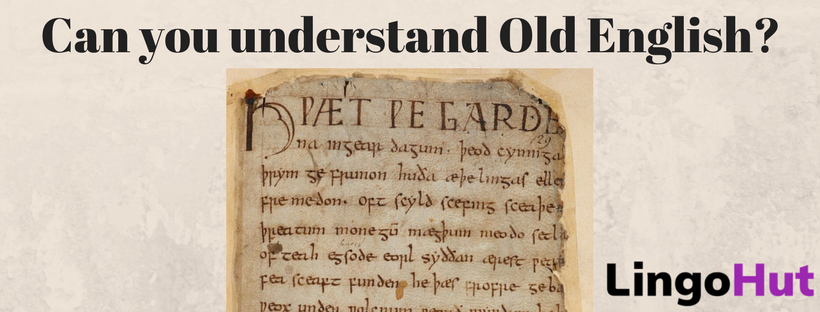

English is a pretty old language. Its birth is somewhere around the 5th century, which was a time when Romans were declining in Britain and the Anglo-Saxons were taking control of the island. With the strength of the Anglo-Saxons growing, English too was growing and forming. Actually, another word for Old English is “Anglo-Saxon”!
However, this was only the early infancy of English, and just like a baby, it was completely unrecognizable to what it became. Old English was a completely different language from what we know today, and today’s English speakers would view it as a foreign language.
An Old English story you may have heard is Beowulf. You may remember this story from high school or from the 2007 Beowulf film with Angelina Jolie. The story is generally considered to be one of the oldest stories in English and is about a hero, Beowulf, that undergoes three trials against monsters and a dragon.
Below I have put a few lines of the beginning of the epic poem provided by the Poetry Foundation:
Hwæt. We Gardena in geardagum,þeodcyninga, þrym gefrunon,hu ða æþelingas ellen fremedon.Oft Scyld Scefing sceaþena þreatum,monegum mægþum, meodosetla ofteah,egsode eorlas.
Having trouble reading what it said? I certainly can’t read a lick of it! Here is a Modern English translation from the Poetry Foundation to help you out:
LO, praise of the prowess of people-kingsof spear-armed Danes, in days long sped,we have heard, and what honor the athelings won!Oft Scyld the Scefing from squadroned foes,from many a tribe, the mead-bench tore,awing the earls.
English since then has clearly made a lot of changes! So much so that it is hard to call both of these languages the same at all. However, it didn’t quickly change overnight. By 1150 AD, Middle English started to take root, which is an intermediary between what Beowulf was like and what English is like today. A good example of Middle English is The Canterbury Tales by Geoffrey Chaucer, which was written around 1387. Here is a section of The Canterbury Tales, provided by the University of Michigan Library:
Whilom, as olde stories tellen us,Ther was a duc that highte theseus;Of atthenes he was lord and governour,And in his tyme swich a conquerour,That gretter was ther noon under the sonne.
The story reads like this:
LO, praise of the prowess of people-kingsof spear-armed Danes, in days long sped,we have heard, and what honor the athelings won!Oft Scyld the Scefing from squadroned foes,from many a tribe, the mead-bench tore,awing the earls.
The Middle English in The Canterbury Tales is a bit easier to read and you can most likely piece together what they are talking about if you know the context. However, it still seems a bit foreign when you are reading it as a Modern English speaker.
Check out this awesome video below of Professor Justin A. Jackson from Hillsdale College read the opening lines of the Old English Beowulf.